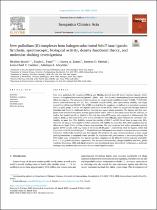| dc.identifier.citation | Waziri, I., Yusuf, T.L., Zarma, H.A., Oselusi, S.O., Coetzee, L.C.C. and Adeyinka, A.S., 2023. New palladium (II) complexes from halogen substituted Schiff base ligands: Synthesis, spectroscopic, biological activity, density functional theory, and molecular docking investigations. Inorganica Chimica Acta, 552, p.121505. | en_US |
| dc.description.abstract | Two novel palladium (II) complexes Pd(L1)2 and Pd(L2)2 derived from ON donor bidentate ligands: 2-(((2-bromo-4-chlorophenyl)imino)methyl)phenol (HL1) and 2-(((-bromo-4-methylphenyl)imino)methyl)phenol (HL2) are reported. The structures of the complexes are unequivocally established using 1H NMR, 13C{H}NMR, Fourier transform-infrared, UV–Vis, TGA, elemental analysis (CHN), mass spectrometry (HRMS), and single crystal X-ray diffraction (SCXRD). The SCXRD revealed that the complexes crystallized as a monoclinic system in P2(1)/c space group, in which two ligands coordinated to one Pd(II) center via oxygen and nitrogen atoms of phenolate and imine in a bidentate fashion, resulting in a square planar geometry. The ligands and their complexes were tested for anticancer activity against breast cancer (MCF-7) and colon cancer (HT-29) cell lines, as well as their toxicity profile on HepG-2, a liver cell line, using MTT assays, and compared to 5-fluorouracil (the control). Pd(L1)2 was found to be more active and selective than Pd(L2)2, and it reduced the cancerous cells' viability by more than 70%. Pd(L2)2 reduced the viability of MCF-7 and HT-29 cell lines by more than 50%. However, the ligands were unable to reduce cancerous cell viability by more than 40%. Both complexes had no effect on the HepG-2 liver cell line at lower concentrations. The two complexes had higher antioxidant activity against DPPH radicals, with IC50 values of 33.16 and 38.40 μgmL−1, respectively, than the ligands, which had IC50 values of 50.76 and 60.90 μgmL−1. Hirshfeld surface (HS) analysis was used to investigate the non-covalent interaction (NCI) of the complexes and their ligands. The tendency of a pair of chemical species to form crystal packing interactions is computed, which provides the complexes with good contacts in the crystal packing. The DFT studies were performed for the ligands and their complexes at the M06-2X/6-311G (d,p) and LANL2DZ/6–31 + G (d, p) levels of theory, respectively. The structural characteristics, charges (Mulliken and NPA), global reactivity descriptors, MEP, and dipole moments were investigated using this method. Furthermore, a molecular docking study predicted the interactions in the protein–ligand complex. | en_US |

